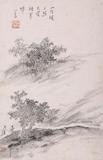清王原祁仿黃公望秋山 軸
推薦分享
資源連結
連結到原始資料 (您即將開啟新視窗離開本站)後設資料
- 資料識別:
- 故畫002462N000000000
- 資料類型:
- 類型:繪畫
- 型式:靜態圖像
- 著作者:
- 王原祁
- 主題與關鍵字:
- 秋景 橋 雲 寒林.枯樹 松 瀑布 房舍 水榭 江河、湖海
- 出版者:
- 數位化執行單位:國立故宮博物院
- 日期:
- 清聖祖康熙五十二年(1713)
- 格式:
- 本幅 105.6x47.8公分、全幅 69公分
- 關聯:
- 石渠寶笈續編(御書房),第四冊,頁,2101&*故宮書畫錄(卷八),第四冊,頁97&*故宮書畫圖錄,第十冊,頁341-342&*王原祁(西元一六四二-一七一五年),江蘇太倉人。時敏孫,字茂京,號麓臺。康熙庚戌進士,歷官少司農。畫由家學,遠邁時倫,為清四大家之一。 麓臺仿子久秋山,傳世者頗多,此本寫贈奕友吳來儀。根據幅上款識,王氏平生並未見過黃公望的秋山圖,此圖乃其懸揣之作。全作的筆墨、設色、章法無不妙絕,為麓臺精品。本幅作於丁亥(一七0七)秋日,王氏時年六十六歲。 &* Wang Yűan-ch’i, a native of Kiangsu province, was the grandson of the painter Wang Shih-min. He served as Vice Minister of Revenue. Wang Yűan-ch’i studied painting in his family and his abilities far surpassed those of his contemporaries, becoming known as one of the Four Masters of the Ch’ing. Wang did many works after autumn landscapes by Huang Kung-wang. He painted this one as a gift for his friend Wu Lai-i. In the inscription, Wang states that he never saw the original by Huang Kung-wang, but his grandfather had often told him about it. Thus, this is based on his grandfather’s description. This work shows Wang at his best, in terms of brushwork, coloring, and composition. It was done in the fall of 1707 at the age of 65. &*1.江兆申,〈清王原祁仿黄公望秋山圖〉,收入胡賽蘭編,《清王原祁畫山水畫軸特展》(臺北:國立故宮博物院,1997年初版),頁123-124。 2.江兆申,〈清王原祁仿黃公望秋山〉,收入胡賽蘭編,《清王原祁畫山水畫軸特展》(臺北:國立故宮博物院,1997年初版),頁132。 3.陳昱全,〈清王原祁仿黃公望秋山〉,收入何傳馨主編,《山水合璧:黃公望與富春山居圖特展》(臺北:國立故宮博物院,2011年五月初版一刷),頁351-354。&*本幅採全景式構圖,左側以斜向堆疊的山體形成蜿蜒走勢,搭配右側樹叢與山體創造出的另一股脈動。兩股大小山體運動間,以水平向的坡岸和小橋匯通左右山體的氣脈。將右下逐漸往上綿延的水域和雲氣描繪成一個個大小不一、相互疊加的半弧形,形成另一個與「實」的山勢相應之「虛」的動向。王氏晚年用筆更趨奔放大膽,直接用花青、汁綠、赭色皴染不同山體塊面,映襯著朱紅的樹葉、青綠的水岸,使畫面更為熱鬧繽紛。(20110609)&*This painting uses the complete-scene mode of composition, the left side consisting of piled mountain forms snaking diagonally into the background and complemented by another pulsating form on the right of tree clusters and mountains. Between the motion of the two mountain ranges of different sizes are banks and a small bridge connecting the force between the mountain forms on the left and right. The area of water that gradually extends up from the lower right along with the clouds and mists create arcing forms of differing sizes that complement each other, creating another direction of “solid” mountain force relative to the “void.” In his later years Wang Yuanqi’s brushwork became quicker and bolder, featuring the direct use of cyanine blue, vegetable green, and ochre washes for different parts of the mountains. Set off against the cinnabar red tree leaves and light blue banks, they make his painting appear even more raucous and bustling.(20110609)
- 管理權:
- 國立故宮博物院
授權聯絡窗口
- 國立故宮博物院圖像授權、出版授權、影音資料授權-申請流程說明
http://www.npm.gov.tw/zh-TW/Article.aspx?sNo=03003061






